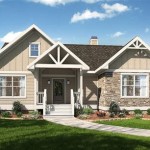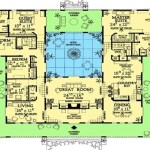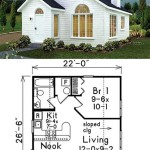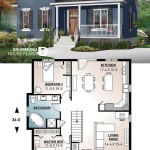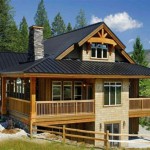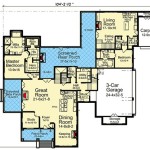Understanding the Split Floor Plan Home Design
A split floor plan is a residential design characterized by distinct separation of living spaces, typically with bedrooms located on opposite ends of the house and the common living areas, such as the kitchen, living room, and dining room, situated in the center. This architectural style maximizes privacy and minimizes noise transfer, making it especially appealing to families and individuals who value defined zones within their home environment.
The split floor plan distinguishes itself from other layouts like the ranch style, which usually positions all bedrooms along one side of the house, or the multi-story design, where bedrooms are generally located on the upper levels. The split design, usually implemented on a single story, offers a blend of accessibility and segregation, making it a versatile option for various lifestyle requirements.
While the exact origin of the split floor plan is difficult to pinpoint, the style gained popularity in the mid-20th century as suburban development expanded. The desire for increased privacy within family homes, coupled with the demand for efficient use of space, likely contributed to its widespread adoption. Today, the split floor plan remains a prevalent choice in both new construction and renovation projects, adapted to modern building standards and design preferences.
Key Benefits of Choosing a Split Floor Plan
One of the primary advantages of a split floor plan is the enhanced privacy it provides. By separating bedroom zones, family members or roommates can enjoy greater autonomy and reduced disturbance. This is particularly beneficial for families with young children, teenagers, or individuals who work from home and require a quiet workspace. The spatial separation minimizes noise transfer, allowing for activities to occur simultaneously without undue disruption.
Another significant benefit lies in the improved functionality for various lifestyle needs. A common configuration of the split floor plan places the master suite on one side of the house and the secondary bedrooms on the opposite side. This layout allows parents to have a private retreat separate from the children's rooms. Alternatively, the configuration can be adapted for multi-generational living, providing separate living spaces for elderly relatives while maintaining proximity and connection within the same home.
The spatial organization of a split floor plan can also contribute to a more organized and efficient household. By clearly defining zones for specific activities, it becomes easier to maintain order and reduce clutter. The central living area serves as a communal space for gathering and interaction, while the separated bedroom wings offer private sanctuaries for rest and relaxation. This segregation of function promotes a sense of balance and harmony within the home environment.
Common Variations and Design Considerations
While the core principle of a split floor plan involves the separation of bedroom zones, there are numerous variations and adaptations of the design. One common variation involves the positioning of the master suite on one side of the house and the secondary bedrooms on the opposite side, connected by a central living area. This configuration is often preferred by families with children, as it provides a clear distinction between the parents' and children's living spaces.
Another variation involves the incorporation of a guest suite or in-law suite within the split floor plan. This configuration entails creating a separate living area with its own bedroom, bathroom, and potentially a small kitchenette. The guest suite is often located on one end of the house, providing guests with privacy and autonomy while still being connected to the main living areas. This is particularly useful when hosting frequent visitors or accommodating elderly relatives.
When designing or renovating a split floor plan, it is crucial to consider several key factors. The size and shape of the lot will influence the overall layout of the house. The positioning of windows and doors should be carefully planned to maximize natural light and ventilation while maintaining privacy. The flow of traffic between the different zones should be seamless and intuitive. Additionally, the choice of materials and finishes can significantly impact the overall aesthetic and functionality of the space.
The placement of the garage is also a consideration. Some split floor plans attach the garage to one side of the house, often near the kitchen for convenient grocery access. Others position the garage at the front of the house, creating a buffer between the living areas and the street. The decision on garage placement depends on the homeowner's preferences and the specific constraints of the lot.
Adapting a Split Floor Plan for Different Lifestyles
The adaptability of the split floor plan makes it suitable for a wide range of lifestyles. For families with young children, the proximity of the secondary bedrooms to the main living area allows for easy monitoring and supervision. For teenagers, the separation of bedroom zones provides a degree of independence and privacy. For empty nesters, the extra bedrooms can be converted into home offices, hobby rooms, or guest suites.
Individuals who work from home can benefit greatly from a split floor plan by designating one of the separated bedroom areas as a dedicated workspace. This allows for a clear distinction between work and personal life, minimizing distractions and promoting productivity. The spatial separation can also help to maintain a sense of privacy and professionalism when conducting virtual meetings or client calls.
The split floor plan can also be adapted for multi-generational living by creating separate living areas for elderly relatives. This configuration allows grandparents or other family members to live independently while still being close to their loved ones. The separation of living spaces provides privacy and autonomy, while the shared common areas foster connection and interaction.
Furthermore, the split floor plan can be easily modified to accommodate individuals with disabilities or mobility challenges. Features such as wider doorways, grab bars, and accessible bathrooms can be incorporated into the design to ensure that the home is safe and comfortable for all residents. The single-story design of most split floor plans eliminates the need for stairs, making it an ideal choice for those with limited mobility.
The flexibility of the split floor plan extends to interior design choices. From minimalist modern to traditional and rustic, the style can accommodate a broad spectrum of aesthetic preferences. The central living area offers a focal point for design expression, while the separated bedroom wings offer opportunities for personalized decoration.
Careful consideration of lighting is essential in a split floor plan. Natural light should be maximized through strategic placement of windows and skylights. Artificial lighting should be layered to create a warm and inviting atmosphere. Dimmer switches can be used to adjust the lighting levels to suit different activities and moods. The separation of zones also allows for more focused lighting schemes, such as task lighting in the kitchen and reading lamps in the bedrooms.
In summary, the split floor plan is a versatile and adaptable design that offers a range of benefits for various lifestyles. Its emphasis on privacy, functionality, and spatial organization makes it a popular choice for families, individuals, and multi-generational households. By carefully considering the various design considerations and variations, homeowners can create a split floor plan that perfectly suits their needs and preferences.

What Makes A Split Bedroom Floor Plan Ideal The House Designers
Split Level Homes Designs G J Gardner

Split Foyer Plan 1678 Square Feet 3 Bedrooms 2 Bathrooms Alexis Level Floor Plans Basement House

5 Reasons To Pick Split Bedroom Designs The House Designers

Split Level Home Designs Stroud Homes

Modern Split Level House Plans And Multi Floor Plan Designs

4 Bedroom Split Level House Plan 2136 Sq Ft 2 Bathroom

Split Level House Plans Floor Designs

House Design Plans Idea 7x11 5 With 3 Bedrooms S Split Level Floor Tri

The Unique Shapes Of Minto S Back Split Designs In 60s And 70s

